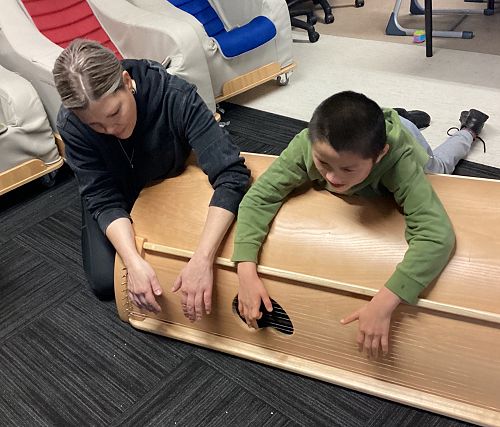
Intensive Interaction
A Person Centred Approach for Learning to Communicate and Relate
What is Intensive Interaction?
Many of our Pītau-Allenvale whānau will have heard the term Intensive Interaction. You may have received some information about it in a whānau pack on transitioning to our school. Perhaps you've had discussions about the approach with a member of our specialist team. Maybe your young person has benefited from an Intensive Interaction approach in the past or is currently benefiting from the approach.
Intensive interaction is a widely recognised and used approach that can help build the fundamentals of communication. It is a person led approach with the main focus being on social connection and enjoyment.
Members of our specialist team involved in this work often see those we work with begin to quickly show increased motivation to engage with others. This engagement eventually leads to initiation using many different communication modes. These modes can include speech, signing, communication books, communication devices, or whatever communication tools the person learns and chooses.
Who is Intensive Interaction good for?
Intensive Interaction is a practical, enjoyable and rewarding way to relate to people who find communication and socialising difficult. It’s a helpful approach to use with those who:
find being with others difficult
can be described as “hard to reach”
have complex learning needs
have multi-sensory difficulties
engage in a range of self-stimulatory or socially isolating behaviours
have challenging behaviours
The Intensive Interaction Institute recognise the fundamentals of communication as:
Enjoying being with another person
Developing the ability to attend to that person
Extending concentration and attention span
Sequencing an activity with a person
Taking turns
Sharing personal space
Learning to regulate and control arousal levels
Using and understanding eye contacts
Using and understanding facial expressions
Using and understanding body language
Using vocalisations meaningfully
and more…
The Intensive Interaction Skills Framework:
The Intensive Interaction skill attainment framework lists these 7 steps to developing the fundamentals of communication:
Encounter
Awareness
Attention and response
Engagement
Participation
Involvement
Initiating Interactions
What we like about the approach:
enjoyable for both people
person centred
intuitive for many
neurodiversity affirming
useful with all ages and stages
practical
no need for specialised equipment
no need to have a goal in mind
an anywhere, anytime, anyone approach
easy to learn the basics
can help form and strengthen relationships
helps us to improve as communication partners
and more…
A Parent's Experience of Intensive Interaction:
Ashton's mother wrote, "After being involved in intensive education program, Ashton made obvious progress in making eye contact, watching, waiting for his turn, joining in an activity etc. Most importantly, he enjoyed the whole learning process and he’s excited about his leading role in our “conversation”.
Ashton has now started initiating use of his communication system and enjoys exploring this at home and at school.
His mother says, 'He loves pointing to “oops” on the communication book and waits for me to respond with an exaggerating tone. Once he felt more confident and comfortable, he started going through the objects on the book and tried to initiate small conversations with me. He even pointed to the real object at home to match the icon on the book during our communication.'
You can see how much Ashton is enjoying the Intensive Interaction approach in 2 of the photos attached to this article.
Ashton's mother expresses, "He was happy along the way and very proud, which is my biggest impression."
Learn more about Intensive Interaction:
If you are interested in learning more about Intensive Interaction, please visit the Intensive Interaction Institute site and see the materials attached to this article. You can also contact Michelle King, Specialist Services Team Leader (michelle.king@allenvale.school.nz).
Gallery




